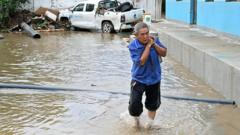The floods in the Miyun District of Beijing have proven deadly, with local officials confirming that 31 residents of a nursing home have lost their lives due to the swift rise of floodwaters. Emergency responders battled through water levels reaching nearly two meters (6 feet) to rescue those trapped within the facility, which primarily serves elderly individuals with disabilities and low-income residents.
The nursing home housed approximately 77 residents at the time of the flood, with around 40 becoming ensnared as conditions rapidly worsened. Local authorities acknowledged inadequacies in their emergency responses and termed the tragedy a "wake-up call." They revealed that the nursing home had been deemed a safe zone in the past, leading to its exclusion from evacuation plans.
The crisis in Beijing forms part of a larger scale of extreme weather events impacting China this summer. In total, 44 individuals have perished in the recent downturn, with further fatalities recorded in nearby Hebei province, where 16 lives were lost to severe rainfall. The regions are still grappling with the aftermath of Typhoon Wipha, which recently left two dead and ten missing in Shandong province.
July marks a particularly difficult month for Beijing, which has a history of severe flooding. The 2012 deluge, where 190mm of rain fell within a day, resulted in 79 fatalities, highlighting the city’s vulnerability to natural disasters, worsened by climate change factors. This year alone, the damage from natural disasters has cost China an estimated 54.11 billion yuan ($7.5 billion), with floods responsible for more than 90% of the losses.
As the country deals with the ramifications of this summer’s extreme weather, experts warn of the ongoing risks posed to residents and industries, particularly agriculture, which is a vital part of the Chinese economy. Policymakers are urged to reassess disaster preparedness and improve response strategies in light of these events and their devastating consequences.


















